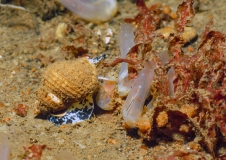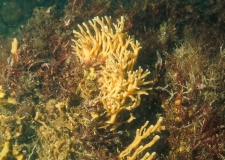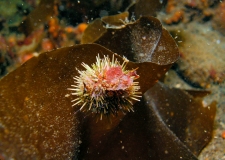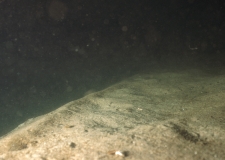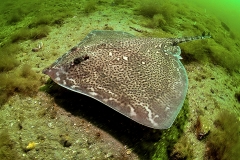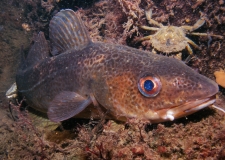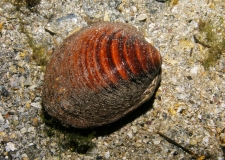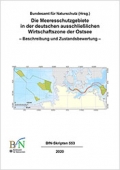The Fehmarn Belt Nature Conservation Area
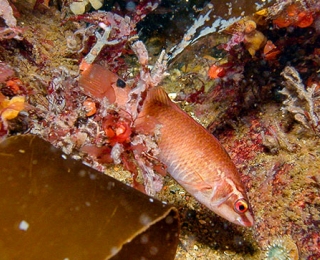
Facts Fehmarn Belt Nature Conservation Area
|
Natura 2000 site placed under national protection as an NCA in 2017 |
||
|
Fact sheet
|
HD site |
|
|
Habitat types |
Sandbanks |
approx. 5.97 km² |
|
Species/Numbers |
Harbour porpoise (Phocoena phocoena) |
>100, seasonal use by additional migrating animals |
Important characteristics of the Nature Conservation Area
Sandbanks with high ecological value and species-rich reef communities are typical for this Nature Consercation Area. Invertebrates and numerous fish species find an ideal spawning and rearing habitat. Marine mammals use the Fehmarn Belt as migration corridor and feeding ground.
At depths of 15 m to 22 m the southern section of the Fehmarn Belt is characterised by large sand ripples several meters high on the sea floor. Their origin has not been sufficiently clarified yet. These so-called megaripples with a crest height of approximately 3 m are a special formation of the habitat type sandbanks and are of particular geo-scientific and ecological value due to their rarity. They are populated by small-scale heterogeneous, species-rich benthos communities, which include such characteristic species as Astarte bivalves (Tridonta ssp.) and ocean quahog (Arctica islandica).
The reefs in the protected area consist of fields of partly dense glacial boulder deposits. They are home to several of the species-richest marine communities in the Baltic Sea and are populated with brown and red algae in water depths of up to more than 20 m. These extensive algae stocks are an essential feature of the Fehmarn Belt reefs and provide a structure and habitat for many organisms to grow on. The Hornwrack bryozoan (Flustra folicea) and the mermaid's glove sponge (Haliclona oculata) offer additional structures. So, species-rich benthos communities develop on the boulders in the presence of the macrophytes. These benthos communities are dominated by numerous sponge and bivalve species. If constantly good environmental conditions exist, especially sensitive and long-living species such as the common whelk (Buccinum undatum) and red whelk (Neptunea antiqua)
can also be found. From the early 2000s, researchers engaged in identifying areas of particular protection value discovered species from all major groups that had not been detected in the Baltic Sea for years or even decades. Consequently, a significant number of benthos organisms included in the Red List of endangered species of the German Baltic Sea were recorded in the Fehmarn Belt NCA.
In the site description of the Baltic Sea NCAs (Script 553), the main anthropogenic uses of the sea in the Fehmarn Belt NCA have been identified and evaluated, and the conservation degrees of the conservation features have been formulated. Through this it became clear that the reefs existing here still show a medium deficiency.
The close interlocking of sandbanks and reefs ensures the occurrence of a multitude of bottom-dwelling organisms and invertebrates. The abundance of food as well as the currents and the water exchange in the Fehmarn Belt trench along with good oxygen conditions and high biological production attract many different fish species. They find shelter and spawning opportunities between boulders densely overgrown by macrophytes.
The NCA is therefore an ideal breeding and rearing area, not least for commercially fished species such as cod.
Harbour porpoises (Phocoena phocoena) regularly swim through the Fehmarn Belt while migrating. They are found in the NCA and the waters around Fehmarn. The area seems to be of significant importance for these animals – not only as a migration corridor, but also as a feeding area. Mother-calf pairs are also regularly sighted here. Since 2002, harbour porpoises have been counted through aerial surveys over the German Baltic Sea undertaken on behalf of the BfN. They have also been detected acoustically by means of underwater microphones (so-called porpoise click detectors or PODs) that record the sounds ("clicks") of the harbour porpoises. The results of the BfN harbour porpoise monitoring and additional interesting data from this project, e.g. frequencies over the course of a year, can be found in the annual monitoring reports and BfN's interactive chart applications.
In the site description of the Baltic Sea NCAs (Script 553), the main anthropogenic uses of the sea in the Fehmarn Belt NCA were identified and evaluated. Through this, it became clear that despite all the conservation efforts undertaken by BfN, there is still unfortunately a high deficiency in the conservation degree of the harbour porpoise population as a whole, not only within this NCA.
As another species from Annex II of the Habitats Directive, harbour seals (Phoca vitulina) that use the area for foraging are also protected in the Fehmarn Belt NCA. They belong to the Danish and south Swedish harbour seal population and visit the area regularly on their prowls. A medium deficiency in the degree of conservation was detected for the harbour seals in the years from 2011 to 2019.
The conservation targets and conservation objectives for the Fehmarn Belt NCA result from §3 of the Protected Area Ordinance (NSGFmbV). They include, in particular, the maintenance and restoration of:
- The specific ecological functions, biodiversity and natural hydro- and morphodynamics of the area, especially as a corridor for the undisturbed exchange of saltwater streaming in aperiodically from the North Sea and brackish water streaming out of the Baltic Sea;
- The Fehmarn Belt as a main migration path into the eastern Baltic Sea for certain elements of the marine fauna and flora ;
- A favourable conservation status of the habitat types "sandbanks which are slightly covered by sea water all the time" (Code 1110) and "reefs" (Code 1170) with their characteristic and endangered ecological communities and species; beyond this, in particular, the near-natural development of marine macrophytes as well as species-rich gravel, coarse-sand and shell-gravel areas (which as a § 30 BNatSchG biotope type also occur on a small scale in the NCA);
- A favourable conservation status of species protected here in accordance with the Habitats Directive: harbour porpoise and harbour seal, and their habitats.
The most intensive use of the sea in the Fehmarn Belt NCA takes place through shipping. A traffic separation scheme traverses the area from west to east over a width of 4 km. In more than half of the area, the mean density of shipping traffic is between 30 and 80 ships per km² and day. Such high densities of shipping traffic and the associated underwater noise have negative effects, especially on marine mammals, in particular harbour porpoises. But seabirds are also affected, as they are startled or chased away by the approaching ships.
The area is strongly used by both commercial and recreational fishing. For this reason, there is a regulation zone for recreational fishing that is determined by the Protected Area Ordinance in the western part of the Fehmarn Belt. This area - approximately 65 km² - is closed to recreational fishing all year. The area comprises reefs and sandbanks of particular conservation value and which are also important rearing areas for young fish.
Commercial fishing regulations can only be issued within the framework of the EU's Common Fisheries Policy (CFP). The proposed measures are currently in staggered agreement processes, first at a national and then European level.
